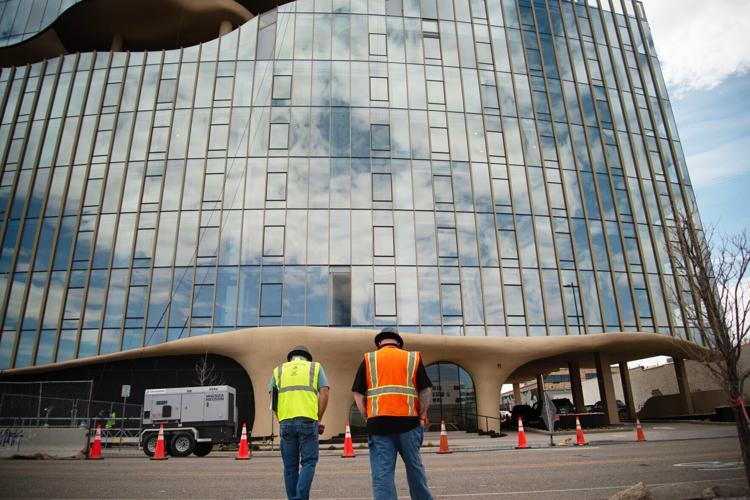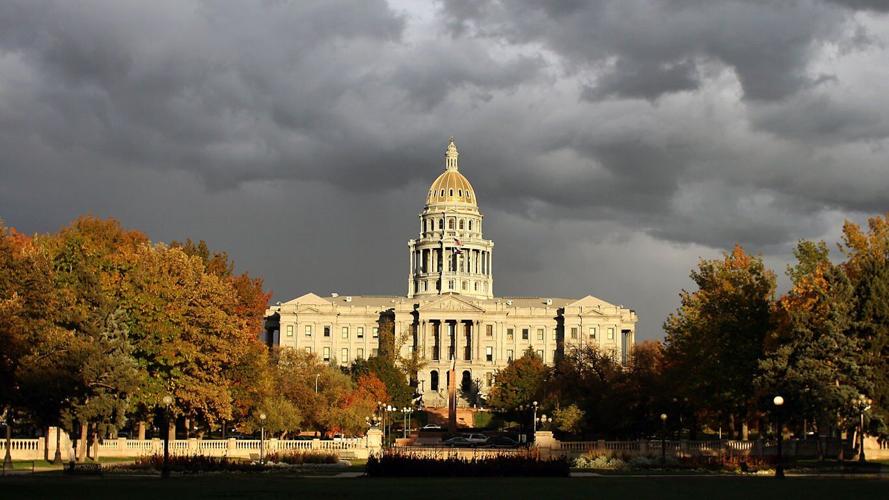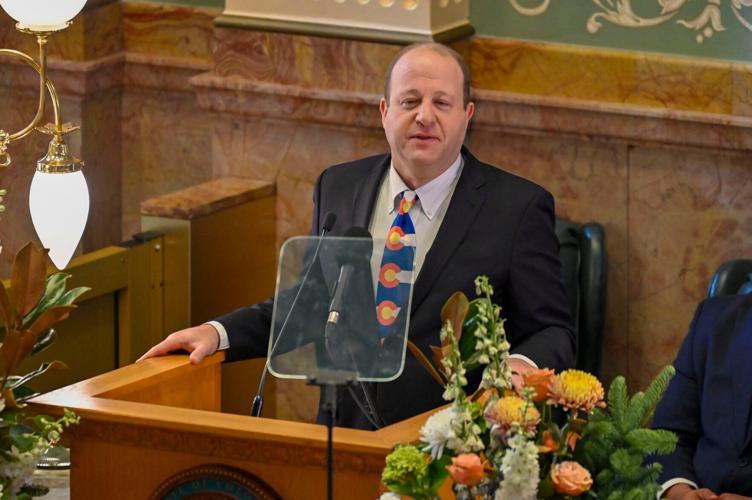Privatizing Pinnacol: What could it mean for the insurance group, retirement and the state of Colorado

FILE PHOTO: Workers examine the exterior of One River North in April as crews put the finishing touches on the Denver luxury apartment development. The region is seeing a construction boom coming to fruition, according to the Apartment Association of Metro Denver’s second quarter report released Thursday, July 25, 2024.
Tom Hellauer/Denver Gazette
As part of his budget plan for the state, Gov. Jared Polis last November suggested allowing Pinnacol Assurance, the quasi-state workers compensation insurance company, to privatize.
The privatization, assuming it happens, is a crucial part of the governor’s efforts to help solve a $700 million hole in the 2025-26 state budget.
A state asset that ‘can be spun off’
In the governor’s Nov. 1 budget request, the Office of State Planning and Budgeting (OSPB) explained that a portion of Pinnacol is a state asset “that can be spun off.”
That would allow Pinnacol to offer its insurance products beyond the state’s borders to Colorado companies with employees in other states.
According to OSPB, spinning off the company would benefit the state by $100 million in 2025-26 and up to $300 million in outyears. Beginning in 2025-26, the $100 million would help cover a portion of the state’s required $225 million payment to the Public Employees’ Retirement Association, an annual amount dictated in legislation from 2018 to help with PERA’s unfunded liability.
That would, in turn, free up $100 million from the PERA obligation to cover other state obligations.
The Pinnacol money in future years also would go to cover a portion of the annual PERA payment, the OSPB analysis said.
What is Pinnacol?
Pinnacol, a domestic mutual insurance company, insures about 50,000 companies and one million workers in Colorado. It is the largest provider of worker’s compensation insurance in the state, which includes workers ‘compensation insurance “of last resort.”
That applies to companies that cannot insure other workers’ compensation insurance. This is an issue for high-risk industries, such as construction, manufacturing, certain healthcare occupations, and oil and gas.
Pinnacol was born from the state’s 1915 Workers’ Compensation Act, then known as the State Compensation Insurance Fund (SCIF). At that time, it was under the state’s Department of Labor and Employment and categorized as a political subdivision of the state. This designation allowed it to perform a limited state function.
In 1987, SCIF, with the permission of the Colorado General Assembly and governor, became a quasi-public authority, no longer under the control of any state agency.
In 2002, the SCIF, then known as the Colorado Compensation Insurance Authority, was rebranded as Pinnacol Assurance. The legislation mandated that Pinnacol become a mutual insurance company and be free from state administrative direction, aside from allowing the governor to appoint its board of directors and keeping its employees in the state’s pension plan.
The company was underwater then, but the state provided $80 million in seed money. Since then, policyholders have built up the company’s reserves and surplus.
The company’s market share in Colorado has been as high as 60%. However, that share has declined over the past decade, now sitting at just under 50%, and continues to head south.
Pinnacol today
The company’s future is tied to its ability to build its market, and where Pinnacol is looking for most growth is outside of Colorado.
Twenty-five states have laws prohibiting a political subdivision from being a licensed insurance carrier in their state, including Colorado.
Why does this matter? States with this law prohibit a state-affiliated subdivision from operating in another state. A state-affiliated insurer, for example, would be able to avoid paying premium taxes in the other state.
The issue for Pinnacol deals with employers who have employees in states outside of Colorado. Pinnacol prohibits offering workers’ compensation insurance in those 25 states, including in neighboring places like Kansas, Wyoming, Oklahoma, and New Mexico.
In those situations, Pinnacol would use a third-party insurer, which can be far more expensive than what Pinnacol charges.
Pinnacol CEO John O’Donnell told the Joint Budget Committee on Jan. 15 that the company is at a crossroads. Decisions during the pandemic accelerated an increasingly dispersed workforce, and he noted that Colorado has the second-highest remote workforce in the country.
Half of Colorado employers have employees outside of Colorado, and given that Pinnacol cannot offer insurance to those out-of-state workers, those companies— as many as 95% — are going elsewhere. That leaves Pinnacol with more high-risk companies, which come with higher premiums and, in the long term, reduces the services it can offer as the market share continues to drop, according to company sources.
The governor’s proposal would allow Pinnacol to address the needs of Colorado employers and their employees, both within Colorado and for out-of-state employees.
If Pinnacol were to leave state control, it would still be able to avoid paying premium taxes for the policies covered under the “insurer of last resort” category but would have to pay them for all other policies. According to OSPB, that would result in a savings of about $5 million annually.
Pinnacol would also benefit from the conversion with greater access to capital markets, the ability to diversify and balance its risks, “and give its policies financial backing via the Colorado Insurance Guaranty Association, all of which should also ultimately benefit policyholders, injured workers, and their dependents,” OSPB said in its Jan. 15 briefing.
Pinnacol would also start paying state and federal taxes, “which would improve the state budget and reduce the level of cuts during the next recession and should help place Pinnacol on par with its competitors,” OSPB said.
Should Pinnacol go private, what happens to its state mandate of being the insurer of last resort?
Pinnacol could work out an agreement or contract with the state to continue providing that insurance, although it could wind up competing with other insurers that may want to bid for that business.
In the last decade, at least seven states have privatized state-affiliated workers’ compensation insurers.
What will it cost Pinnacol?
For Pinnacol, the issue is capital. The company’s assets to cover its current and future claims stand at about $1.5 billion, and the company brought in $530 million in premiums in 2023, according to OSPB. (Pinnacol says its assets are valued at $1.3 billion.)
O’Donnell told the JBC that, in order to maintain successful coverage for workers, a divestment of any magnitude must be carefully balanced with adequate reserves to cover all the claims and to continue to support injured workers, in addition to the capital adequacy necessary to maintain stable pricing, industry-leading services, and adapting to modern workforce trends.
The proposal from the Polis administration could cost the company around $500 million.
Or more.
The first portion of that is what Pinnacol would pay the state to get out from under the quasi-state control, with one estimate pegged at about $300 million to $400 million.
The rest is what Pinnacol could be required to pay the Public Employees Retirement Association (PERA) for its share of PERA’s pension liability for Pinnacol’s 650 plus current employees and 409 retirees. That’s $317 million, determined by a November 2024 actuarial analysis and based on a Dec. 31, 2023 valuation.
Combine the two, and that may exceed what Pinnacol is willing to pay to go private.
There is some wiggle room in what’s known as a “discount rate.”
According to PERA CEO Andrew Roth, the retirement group is seeking a rate of 5.25%, or about 2 percentage points less than its current investment return assumption. The 5.25% rate is set in statute and accounts for risk.
PERA also asked its actuary to consider higher discount rates, including 7.25%, which is PERA’s current investment assumption and the number Pinnacol hopes for.
At that rate, Pinnacol’s cost to exit PERA would drop to just under $184 million, but the final number is more likely to be somewhere in the middle.
Roth told Colorado Politics that PERA would do an updated valuation for June but believes the numbers would not change significantly.
If a bill authorizing the negotiations surfaced in the 2025 session, the final number would be set in the legislation.
Pinnacol’s “disaffiliation” wouldn’t be the first for PERA.
In 2012, the City of Colorado Springs, which owned Memorial Hospital, wanted to lease it to the University of Colorado Hospital, a move that would have removed the hospital’s employees — PERA members — from the pension plan. The city sued PERA over its demand that the city pay for the pension liabilities for those 4,000 hospital employees.
According to PERA, that would require about $190 million from the city.
The city said no, but in 2014, a mediator, a retired judge, ruled that the city had ignored the process of pulling the Memorial Hospital employees out of PERA, “including the important step of paying PERA for future liabilities caused by the mass departure.” The settlement that ended the lawsuit gave PERA its $190 million.
It’s the only time a PERA-covered employer has gone through litigation to disaffiliate from PERA.
A new year, an old idea
The idea of Privatizing Pinnacol is nothing new and has been tried multiple times over the past two decades. Pinnacol has favored the move, but lawmakers haven’t budged.
The most recent was in 2021, when Rep. Matt Soper, R-Delta, sponsored House Bill 21-1213, which would have accomplished much of what’s being proposed in 2025.
Then-Pinnacol CEO Phil Kalin said fewer and fewer Colorado companies were insuring through Pinnacol and that those opposed to HB 1213 — which included labor unions and the Workers Compensation Education Association, an association of worker’s compensation attorneys — said the company’s stellar performance was the result of state oversight. But the limitation put on Pinnacol by the state is strangling the company and driving businesses to out-of-state companies, he said.
Soper diverged from the current proposal, which would have some of the money go to the Office of Just Transition, which would help coal miners on the Western Slope transition to new jobs. This has been a huge issue for Delta County, where closures have cost more than 800 miners their jobs.
But lawmakers voted resoundingly “no” to the bill. Democrats sided with the labor unions and attorneys representing injured workers, and Republicans disagreed with putting the money into the Just Transitions office or toward controlled maintenance.
Soper told Colorado Politics this week that while he was initially skeptical, he fully supports Pinnacol privatization and has kept an eye on the conversations.
The value of Pinnacol — from when he ran the bill in 2020 — to today has dropped, Soper said. Because it’s a diminishing asset, “my argument for why the legislature needs to act now rather than delay is we have already seen the cost of delay,” he said, calling it an opportunity cost.
He said it would be better to privatize Pinnacol now, in a bad economic year, although the asset is worth significantly less.
The legislation for the 2025 conversion could surface sometime in March. That’s when the state anticipates receiving a draft from an outside company that will value the state’s share of Pinnacol. The state sought bids for that work but has not yet decided who will do the valuation.
The legislation will likely take place first, which would then authorize the negotiations between the state and Pinnacol.
That does not mean, however, that it would be a done deal.
Another question is just who would sponsor that legislation.
Will the Joint Budget Committee support the concept?
Soper and others have said the goal is for the proposal to come from the JBC. Soper, however, said he would be interested in sponsoring it if that doesn’t happen.
“Now is the time to act,” he added.
The JBC received the governor’s proposal — and a subsequent update on Jan. 15 — and has been meeting with Pinnacol over the issue.
The legislation that could set the wheels in motion could come in the form of a a JBC bill that would take a “yes” vote from all six members. It’s an open question whether all six would do so, and sources said there are still many questions to be answered for the committee to take on such a significant policy undertaking.
“I’m open, but with questions,” said JBC Chair Sen. Jeff Bridges, D-Greenwood Village.
Vice-Chair Rep. Shannon Bird, D-Westminster, said she is in a “wait and see mode.” She has found the conversations with Pinnacol, the state, and PERA helpful but believes more “due diligence” needs to be done.
She added that the transaction must stand on its own merits and the state should not be pressured to do it to balance the budget.
Bird said Pinnacol has a legitimate case to make for its own future viability.
“They can’t keep great coverage and low rates if they’re no longer competitive and can’t spread the risk over a growing number of insureds,” she said.
Yet she also wants to make sure there will always be an insurer of last resort.
“That has to be protected,” she said.
“We’re counting on a significant amount of money to come from this deal,” she said. “Right now, that data needs time to ‘prove up’ and whether the negotiations and analysis support what’s being offered.”
Sen. Barbara Kirkmeyer, R-Brighton, has been skeptical of the conversion plan, mainly because of the amount of due diligence needed before the deal can be crafted.
And that hasn’t been done, she told Colorado Politics.
“It’s an incredibly complex policy,” she said, questioning whether it could be accomplished in time to put that $100 million, or whatever the state gets, into the 2025-26 state budget.
Part of her worry is also that whatever the state gets is one-time money, and that’s an issue for the JBC, which has been dealing with the fallout from using one-time funds for the past several years.
Kirkmeyer believes the state’s gain from the spin-off will be far below the $500 million projected, maybe closer to $180 million outside of what PERA will receive.
“I don’t even think that’s feasible for Pinnacol to ensure they remain stable,” she said.
Labor unions remain opposed; businesses support the idea — with conditions
The strongest opposition to Pinnacol privatization is likely to come from labor unions.
The AFL-CIO was among the leaders of the opposition to the 2021 legislation, and according to Kjersten Forseth of Red Rocks Strategies, which lobbies on behalf of the AFL-CIO, that hasn’t changed.
The opposition is based on the belief that Pinnacol functions as a social safety net for workers, particularly given its large market share. Forseth pointed out that the second-highest provider of workers’ compensation insurance has only a 2% market share.
The AFL-CIO struggles with the idea of talking about Pinnacol as if it’s just a private company, she said.
“It’s actually a public company, and it’s meant to be there as provider of last resort so that costs don’t go up for employers, which is the most important for us,” she said.
The more costs go up, the more likely employers will not carry workers’ compensation insurance, she said.
Forseth said workers could be injured or even die on the job, and they would have no coverage at all. The state has an uninsured fund, but the claims far surpass the money that can be collected against companies that violate the law.
“Workers are left hanging,” she said.
AFL-CIO’s major concern is ensuring low-cost workers’ compensation insurance. The second is that Pinnacol performs a “public good,” which includes refunding premiums back to its ratepayers, which it has been doing for years, the result of a 2010 legislation.
“They’re saving money for ratepayers,” Forseth said.
AFL-CIO also believes the company is not in financial distress, according to Forseth.
“They have a competitive edge in the market,” she said, adding that gives private insurers a little heartburn on the potential to leverage public dollars into the private market.
“I have yet to hear a proposal that proves that workers and employers don’t lose out on this deal, that they don’t end up holding the bag with increased costs,” Forseth said.
Carly West, vice president of government affairs for the Metro Denver Chamber of Commerce, told Colorado Politics that the chamber supports privatization. But, from the chamber’s perspective, it is critical that the number is fair and reflects the existing system, what everyone put in and got out of it, and not to treat this as a “cash cow” for the legislature, she said.
West said that businesses have paid premiums into the system for years, and the state got value from taxes from that. The balance and fairness are the main issues for the chamber, not whether privatization is a good idea, she said.







